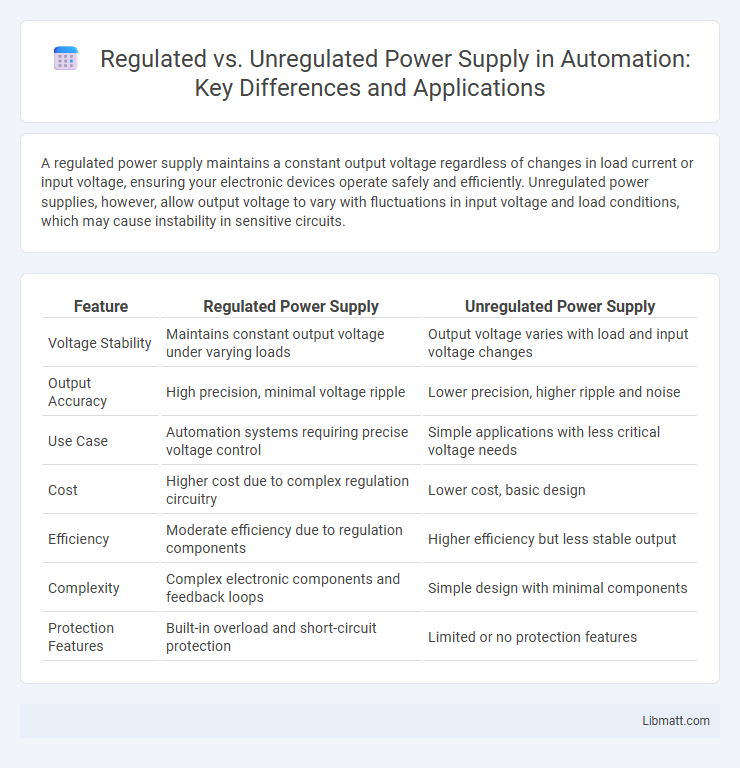A regulated power supply maintains a constant output voltage regardless of changes in load current or input voltage, ensuring your electronic devices operate safely and efficiently. Unregulated power supplies, however, allow output voltage to vary with fluctuations in input voltage and load conditions, which may cause instability in sensitive circuits.
Table of Comparison
| Feature | Regulated Power Supply | Unregulated Power Supply |
|---|---|---|
| Voltage Stability | Maintains constant output voltage under varying loads | Output voltage varies with load and input voltage changes |
| Output Accuracy | High precision, minimal voltage ripple | Lower precision, higher ripple and noise |
| Use Case | Automation systems requiring precise voltage control | Simple applications with less critical voltage needs |
| Cost | Higher cost due to complex regulation circuitry | Lower cost, basic design |
| Efficiency | Moderate efficiency due to regulation components | Higher efficiency but less stable output |
| Complexity | Complex electronic components and feedback loops | Simple design with minimal components |
| Protection Features | Built-in overload and short-circuit protection | Limited or no protection features |
Introduction to Power Supplies
Power supplies convert electrical energy to the appropriate voltage and current needed by electronic devices, playing a crucial role in system stability. Regulated power supplies maintain a constant output voltage despite load or input voltage variations, ensuring reliable performance for sensitive electronics. Unregulated power supplies provide a varying output voltage that fluctuates with changes in load and input, making them suitable for applications where precise voltage is less critical.
What is a Regulated Power Supply?
A regulated power supply maintains a constant output voltage regardless of variations in input voltage or load conditions, ensuring stable and reliable power for sensitive electronic devices. It uses components like voltage regulators, feedback circuits, and filtering to control fluctuations and reduce ripple effects. This precise voltage control distinguishes it from unregulated power supplies, which can have varying output based on input and load changes.
What is an Unregulated Power Supply?
An unregulated power supply provides a DC output voltage that varies in response to input voltage fluctuations and load changes, lacking any mechanism to maintain a constant voltage. Typically composed of a transformer, rectifier, and filter capacitor, it delivers raw, unsteady power suitable for less sensitive electronic devices. Voltage ripple and noise are common issues, which can affect the performance of circuits requiring stable and precise voltage levels.
Key Differences Between Regulated and Unregulated Power Supplies
Regulated power supplies maintain a constant output voltage regardless of load variations or input voltage fluctuations, ensuring stable and reliable performance in sensitive electronic devices. Unregulated power supplies lack voltage stabilization, causing output voltage to vary with changes in input voltage and load, which can lead to inconsistent device operation. Key differences include output voltage stability, complexity, and cost, with regulated power supplies typically being more complex and expensive but essential for precision applications.
Components Used in Regulated Power Supplies
Regulated power supplies utilize components such as voltage regulators, Zener diodes, and operational amplifiers to maintain a constant output voltage despite input fluctuations or varying load conditions. These components work together with transformers, rectifiers, and filtering capacitors to ensure stable and precise voltage delivery. Your electronic devices benefit from the consistent performance and protection offered by these carefully selected components in regulated power supplies.
Components Used in Unregulated Power Supplies
Unregulated power supplies typically use simple components such as transformers, diodes, and capacitors to convert and smooth AC voltage into DC voltage without maintaining a constant output level. The transformer steps down the voltage, while the diode rectifier allows current flow in a single direction, and the capacitor reduces voltage ripple. Your choice of components impacts the efficiency and stability of the power supply in applications where precise voltage control is not critical.
Advantages of Regulated Power Supplies
Regulated power supplies provide a stable and consistent output voltage regardless of variations in input voltage or load conditions, ensuring reliable performance for sensitive electronic devices. Their ability to minimize voltage fluctuations and noise enhances the longevity and efficiency of your equipment. Choosing a regulated power supply protects your circuits from damage caused by power surges or drops, making it the preferred option in precision applications.
Advantages of Unregulated Power Supplies
Unregulated power supplies offer simplicity, lower cost, and higher efficiency compared to regulated power supplies, making them ideal for applications where precise voltage control is not critical. Their minimal component count reduces the likelihood of failure and eases maintenance. You benefit from these power supplies in systems where fluctuations in voltage do not impact overall performance or device lifespan.
Typical Applications and Use Cases
Regulated power supplies are essential in applications requiring stable voltage and current, such as sensitive electronic testing equipment, microcontrollers, and communication devices to prevent damage and ensure reliable operation. Unregulated power supplies are commonly used in simpler devices like battery chargers, basic lighting systems, and household appliances where voltage fluctuations do not critically impact performance. Choosing between regulated and unregulated power supplies depends on the precision requirements and sensitivity of the electronic components in the use case.
How to Choose Between Regulated and Unregulated Power Supplies
Choosing between regulated and unregulated power supplies depends on the precision and stability required by your electronic device. Regulated power supplies provide consistent output voltage regardless of load fluctuations, ideal for sensitive electronics needing protection from voltage spikes. Unregulated power supplies are suitable for less sensitive applications where small voltage variations are acceptable, offering a cost-effective and simpler design choice.
Regulated Power Supply vs Unregulated Power Supply Infographic

 libmatt.com
libmatt.com